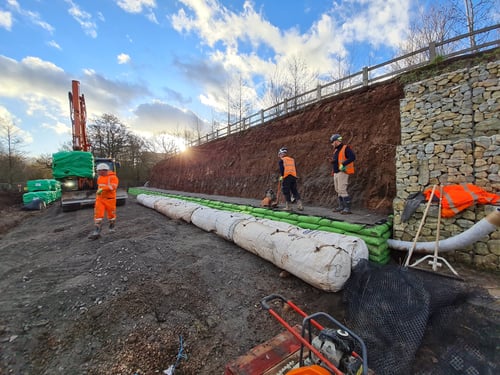Benniman
330m retaining wall
Blythe Valley Business Park, Solihull
At the site in Solihull, a steep cement-stabilised slope was experiencing severe erosion, leading to 12 significant landslips along its 330m length. This posed a serious risk to the car park and haulage yard above, as well as the surrounding landscape. Given the site’s designation as a Public Right of Way (PROW), we faced several challenges, including:
- Limited site access
- No working from the top of the slope
- Minimal space at the toe
- Existing drainage services, including an open channel and a concrete-surrounded drainage run
Our goal was to deliver a sustainable and effective long-term solution that would stabilise the slope, prevent further erosion, and blend seamlessly with the natural surroundings of the adjacent nature reserve.

Appointed by Bennimans Ltd, we worked closely with the land agent managing the business park to design and implement an environmentally friendly solution.
Since the slope faced a nature reserve, it was essential to take a sympathetic approach that respected local wildlife and ecosystems. Our objective was to create a vegetated solution that would provide robust erosion protection while fostering biodiversity.
We began by constructing a stone-filled haulage road to access all working areas while protecting existing assets. To minimise environmental impact, we carefully placed material stockpiles near the wall, reducing the area that required re-civilising post-construction.
Once we removed the eroded surface material, we safely excavated the full slope length at a steep angle, allowing for an efficient construction process. To facilitate safe working at the base, we temporarily filled the open drainage ditch. Given the wall’s height of 5-6m, we installed it in short sections, gradually building up to the full height while adhering to Work at Height Regulations. Fall bags and scaffolding were used where necessary.
The foundation of the wall consisted of a binding concrete layer, which we tested to confirm its bearing capacity. Any soft materials were excavated and replaced with a lean mix concrete to achieve the required stability. We then installed a geogrid layer directly on top of the concrete base, followed by interlocking plates and the first row of Rootlok® bags. Granular stone backfill was placed, spread, and compacted, with additional geogrid layers installed at approximately 280mm depths until the wall reached the desired height.
To further enhance stability and manage water flow, we reinstated the drainage channel at the toe of the wall, ensuring effective stormwater management. Drainage pipes installed at the back of the wall help relieve hydrostatic pressures, draining water through the face and into the channel.
''We recommended our Rootlok retaining wall system as this approach not only ensured long-term slope stability but also provided cost-saving benefits while enhancing the site’s natural aesthetics.''
Dan Roberts
Technical Director
Once construction was complete, we reinstated the pathways and surrounding areas to their original levels. Our in-house environmental team hydroseeded the Rootlok® wall using a drought- and shade-tolerant seed mix. For all other areas, we used a wildflower meadow seed mix to promote biodiversity and enhance the local ecosystem.
The project was completed ahead of schedule, and with agreed changes, we delivered significant time and cost savings. The Rootlok® Vegetated Wall System now provides long-term erosion protection to the slope, reducing the risk of future landslips. The larger stormwater channel will also prove beneficial during heavy rainfall, ensuring effective water management.
By late spring and early summer, nursery grasses will establish early vegetational growth, while wildflowers will bloom later in the year. This will create an aesthetically pleasing landscape while supporting biodiversity, wildlife habitats, and sustainability.
Our work at Blythe Valley Business Park demonstrates how engineered solutions can harmonise with the natural environment, delivering both functional and ecological benefits. By integrating sustainable practices into erosion control, we have not only stabilised the slope but also enhanced the overall landscape for years to come.






Comments